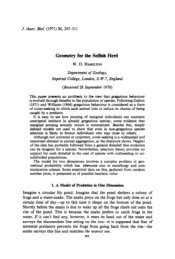Jenis Crinoid Feather Stars
Jenis Crinoid Feather Stars
Jenis Crinoid Feather Stars
Create successful ePaper yourself
Turn your PDF publications into a flip-book with our unique Google optimized e-Paper software.
• They are the most common fossils from Paleozoic-age marine rocks and were<br />
most diverse at this time because they were able to live in shallow water where<br />
plankton was abundant.<br />
• They were able to live in the shallow water where the predators could see them<br />
because Paleozoic predators were less efficient than modern predators.<br />
• Many different kinds of stalked crinoids were able to evolve by specializing on the<br />
kinds and sizes of plankton that they ate because plankton is variable in size and<br />
has a large range of different types of algae and microscopic animals.<br />
• They were major carbonate producing organisms during the Paleozoic and<br />
Mesozoic Eras with entire carbonate shelves composed mostly by crinoidal.<br />
Carboniferous crinoid<br />
• The geological history of the crinoids demonstrates how well the echinoderms<br />
have adapted to filter feeding and the fossils of other stalked filter-feeding<br />
echinoderms, such as blastoids, are also found in the rocks of the Palaeozoic<br />
era.<br />
o <strong>Crinoid</strong>s evolved a plant-like morphology so that they could remain<br />
attached to the seafloor while they spread their arms to catch food.
















